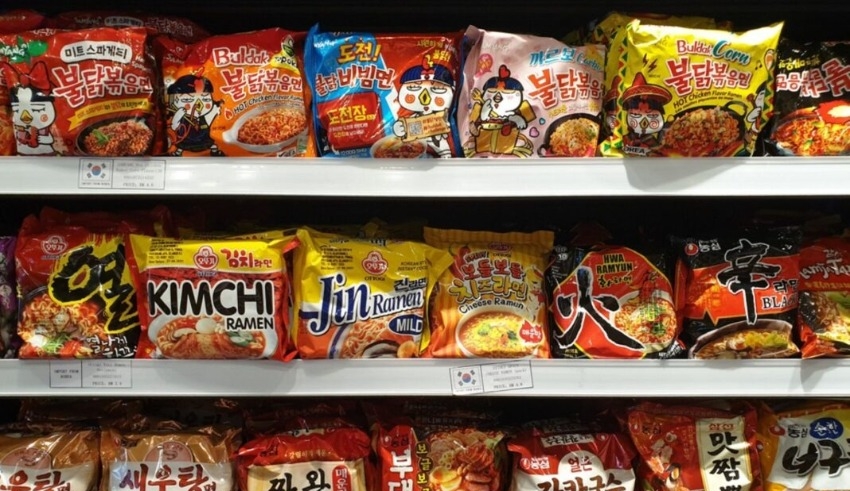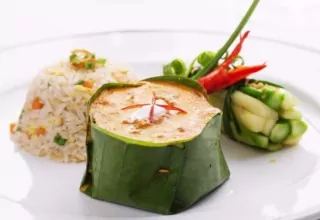
The craze for instant noodles is quite genuine, and it’s not just because they’re easy on the wallet or make for a soothing midnight snack. We just can’t get enough of this salty and occasionally spicy umami-bomb, and it’s showing up everywhere from viral challenges to picturesque museums.
Despite the fact that it has also been affected by the growing expenses associated with inflation, there is no question that it will continue to be a staple for many different homes.
It’s more than just a matter of convenience to slurp down a bowl of noodles while they’re sizzling hot. It brings on a warm and fuzzy feeling of reminiscence, such as the flavor of chicken Maggi mee served by a doting loved one or the joy of sharing your first cup noodle with peers outside of a convenience store after school.
The following is a list of five instant noodles that will completely transform the your meals:
1. Coriander Instant Rice Noodles
The world can be broken down into two distinct camps: those who adore coriander and those who abhor it.
The manufacturer of MAMA instant noodles, which is famous in Thailand, has developed a new product specifically for people who are interested in eating more vegetables.
It only takes four minutes to prepare these coriander cup noodles from the President Rice brand, and they contain both dried coriander and coriander flavoring. The noodles are ready to eat in just four minutes.
The meal is characterized as being salty, peppery, and herbaceous in a number of reviews that can be found on the internet. The responses range from “very fascinating” to “I couldn’t picture eating this full bowl.” Fans of coriander, are you up to the challenge?
2. NongShim Shin Black Noodle Soup
NongShim, the most popular brand of noodles in Korea, produces a wide variety of noodles, just like the majority of other manufacturers. The Spicy Pot-au-feu Flavor, however, was my favorite out of the few that I tasted. It features a complex and spicy broth, hefty dried vegetables, and toothsome noodles, which together make for a winning combination. These were so good that I couldn’t stop eating them.
The Shin Black noodles are a premium variant of NongShim’s famed Shin Ramyun noodles. They come with an additional “sul-long-tang” (ox bone) flavor packet, and they were suggested by the food blogger and cookbook author Maangchi. The soup in Shin Black is made with a milky bone broth imitation, which makes it creamier and less spicy than the soup in the original Shin Ramyun. A few members of the Wirecutter team are huge fans of the original, while others are devoted to the Black noodles. And others argue in Reddit posts and Amazon reviews over whether or not the Black noodles are worth paying an additional couple of dollars for in comparison to the price of the original.
Related Posts
3. Prima Taste Singapore Laksa La Mian
These noodles came highly recommended by the Ramen Rater, who has placed them at the top of his annual rankings of the best instant ramen for the past four years running. He stated that the “broth is just a show stopper with a highly tasty paste and a large sachet of coconut milk powder” in reference to the Laksa La Mian. The soup that is made from the dehydrated coconut milk has just the right amount of sweetness, and it also has just the right amount of salt. The chunky, burnt orange laksa paste has a flavor similar to galangal and dried shrimp, and it has a light level of spiciness. When you combine the two and stir them together, vivid crimson flecks rise to the surface and remind one of the swirling surface of Jupiter. These noodles are different from others because they are air-dried rather than fried, making them longer, thicker, and more straight. They have a flavor that is indistinguishable from the broth, which works well with it.
These noodles are the most costly type. They also had a flavor that was most comparable to a dish that you may order in a restaurant. This meal is more satisfying than standard chicken ramen because the broth is made with shrimp instead of chicken, and each serving has more than twice as much protein as the chicken version does. Taking them to the next level would require a touch of brightness, which may be achieved by adding lime and some fresh herbs.
4. NongShim Chapagetti & Neoguri
This combo ramen dish, also known as jjapaguri, chapaguri, or ram-don, became even more popular (video) in Korea after it was included in the film Parasite, which won an Academy Award for Best Foreign Language Film. It is a combination of two distinct varieties of noodles: one package of Chapagetti, which is a variation of the noodle dish jajangmyeon that is served with black bean sauce, and one package of Neoguri, which has the flavor of a hot seafood stew. NongShim offers a combination box of these tastes, but you may also purchase them singly, and the individual prices are typically lower. This well-known pairing was re-created by Maangchi, who added a side of butter-cooked ribeye steak to elevate the dish to the level it achieves in the film (video). It tastes much better with the meat that’s been added to it.
After being prepared in accordance with Maangchi’s recipe, the springy noodles have an even coating of a sauce that is silky smooth, thick, and earthy. The sweetness of the black bean paste (chunjang) that is used in the Chapagetti sauce is the perfect counterpoint to the funkiness of the shellfish taste in the Neoguri broth. The dark, spongy, dry parts in the Chapagetti mix (supposedly “meat flakes”) did not sit well with me, nor did the carrots, which had a taste that was jarringly overdone and bitter. However, the huge flakes of kombu (kelp) that were used in the Neoguri noodles contributed an additional layer of brininess in addition to a little bit of texture. Both of these were chewier than other types of noodles despite their thicker consistency, which was similar to that of udon. After trying the noodles on their own, I decided to add some steak to the dish, and I found that the fatty meat went very well with the jjapaguri. Although the preparation method for Maangchi was the most involved one I attempted (it requires setting some liquid aside and adding noodles back to the pot after draining), the dish was still ready in less than ten minutes.
5. Oh! Ricey Instant Rice Noodles Pho Bo (Beef Flavor)
When she doesn’t have the time to let a soup simmer for a long period of time, cookbook author Andrea Nguyen likes to eat these fast pho noodles. She claims that although it contains a significant amount of MSG, in about five minutes you will have a bowl of pho that you can slurp up. The presentation of these noodles, which features many dried scallions and thin slivers of “beef” created from wheat protein, enchanted me. I found it particularly appealing because the “beef” was manufactured from wheat protein. It is a pretty accurate version of pho, and it was gratifying to consume this bowl of soup; it felt like a more complete dish than other simple noodles.
I breathed the flavor of anise and the other warming spices as I dipped my face into the scalding soup that was fragrant with the scent of anise. And even though it was a stimulating experience, the Oh! Ricey noodles had a more enticing aroma than they did flavor. The soup was salty, and the broth was quite light, so there wasn’t much flavor to speak of, but a packet of oil gave some much-appreciated fat to the dish. The rice noodles were extremely thin, and once they were cooked, they did not maintain their shape nearly as well as the thicker ramen noodles did. When you chew a substantial amount of them, they have a spongy feel. The preparation of these is made even simpler by the fact that you only need to add water that has been brought to a boil rather than cooking them in a saucepan or the microwave. This meal might easily be made more substantial by adding lime, meat, sprouts, and various herbs.




























